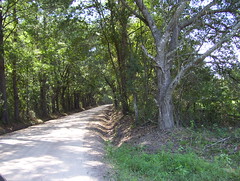I wanted to remember what it was like before it got paved so I took this video.
-gretchen
-gretchen
The yellow dog is right: I burned those trees! Before picture of one of them: Continue reading
“from a traffic safety perspective, the modern commercial arterial is a perfect storm of bad planning and design. These roads are designed to support high operating speeds, making it difficult for drivers to stop quickly to avoid a crash, and the presence of commercial and retail uses on these roads means that drivers will routinely need to stop quickly in order to avoid crashing into pedestrians, bicyclists, and especially vehicles turning in and out of driveways.”The 2006 article, Safe Urban Form: Revisiting the Relationship Between Community Design and Traffic Safety, by Eric Dumbaugh and Robert Rae, notes: Continue reading
 Beta New Urban Network reported 1 September 2006 that
Research: trees make streets safer, not deadlier:
Beta New Urban Network reported 1 September 2006 that
Research: trees make streets safer, not deadlier:
Proposals for planting rows of trees along the roads — a traditional technique for shaping pleasing public spaces — are often opposed by transportation engineers, who contend that a wide travel corridor, free of obstacles, is needed to protect the lives of errant motorists.The study asks a key question: Continue readingIncreasingly, however, the engineers’ beliefs about safety are being subjected to empirical study and are being found incorrect. Eric Dumbaugh, an assistant professor of transportation at Texas A&M, threw down the gauntlet with a long, carefully argued article, ”Safe Streets, Livable Streets,” in the Summer 2005 issue of the Journal of the American Planning Association. A follow-up article by Dumbaugh, in the 2006 edition of Transportation Research Record, will present further evidence that safe urban roadsides are not what the traffic-engineering establishment thinks they are.
Though engineers generally assert that wide clear areas safeguard motorists who run off the roads, Dumbaugh looked at accident records and found that, on the contrary, wide-open corridors encourage motorists to speed, bringing on more crashes. By contrast, tree-lined roadways cause motorists to slow down and drive more carefully, Dumbaugh says.
Dumbaugh examined crash statistics and found that tree-lined streets experience fewer accidents than do “forgiving roadsides” — those that have been kept free of large, inflexible objects. He points to “a growing body of evidence suggesting that the inclusion of trees and other streetscape features in the roadside environment may actually reduce crashes and injuries on urban roadways.”
 We haven’t done one of these in a while: a video drive-through
of a canopy road of south Georgia.
This one is Beatty Mill Creek Road in northeast
Lowndes County. So far northeast its mailing address is Ray City.
It’s not all canopy, but there are a number of stretches of it.
We haven’t done one of these in a while: a video drive-through
of a canopy road of south Georgia.
This one is Beatty Mill Creek Road in northeast
Lowndes County. So far northeast its mailing address is Ray City.
It’s not all canopy, but there are a number of stretches of it.
Video by John S. Quarterman, 7 June 2010.
 The County Commission is scheduled to vote on a revised Thoroughfare Plan for Lowndes County today at 5PM at 325 West Savannah Avenue, Valdosta, GA. Details are here. The plan as submitted to Commissioners Friday appears to be an early working draft not ready for prime time, including as it does uses of terms that are not defined and quite a few internal inconsistencies, as well as conflicts with the
Greater Lowndes 2030 Comprehensive Plan. Commissioners may decide to defer approval until the plan is in better shape.
The County Commission is scheduled to vote on a revised Thoroughfare Plan for Lowndes County today at 5PM at 325 West Savannah Avenue, Valdosta, GA. Details are here. The plan as submitted to Commissioners Friday appears to be an early working draft not ready for prime time, including as it does uses of terms that are not defined and quite a few internal inconsistencies, as well as conflicts with the
Greater Lowndes 2030 Comprehensive Plan. Commissioners may decide to defer approval until the plan is in better shape.
As an example of things in the plan that could use fixing, it proposes to reclassify Quarterman Road from local to minor collector on the basis that within 20 years it might have enough traffic “if it were developed”, despite the Greater Lowndes 2030 Comprehensive Plan showing the same neighborhood as agricultural through 2030. Many other roads are proposed to be reclassified by the new Thoroughfare Plan even though they do not meet the criteria set forth in the same plan itself. The plan might benefit from some additional process or procedural input and review. Fortunately, the Chairman and the County Manager appear to be soliciting input. More details here.
A canopy road, in Georgia, with no curbs or gutters. Sure, it doesn’t go anywhere. Neither does Quarterman Road.
Thanks to Bob Clouston for the pointer.